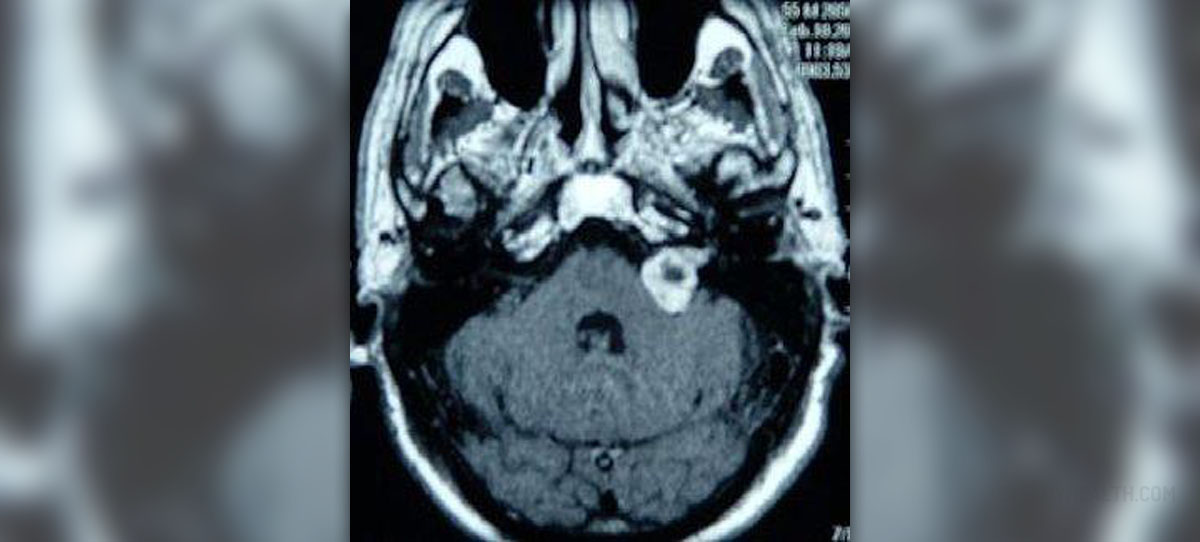
Acoustic neuroma, also known under the name vestibular schwannoma, is a benign tumor stemming from the myelin-forming cells of the 8th cranial nerve (the vestibulocochlear nerve). The tumor is made of Schwann cells. These cells are distributed all over the peripheral nervous system and represent the principal glia. In case of acoustic neuroma, Schwann cells of the 8th cranial nerve start to multiply uncontrollably and form a tumor.
In the United States acoustic neuroma is reported to affect around 3,000 people each year. The prevalence of this benign tumor around the world is 1 in 100,000 and it accounts for 5-10% of all tumors growing inside the cranium. In the majority of cases the tumor is diagnosed in people in their 50s and 60s. Men and women are equally affected.
Acoustic Neuroma - Intracranial Tumor
Acoustic neuromas are reported sporadically and this drives to conclusion that the reason why these tumors occur remains unknown. Still, in some people acoustic neuromas develop due to already existing condition called von Recklinghausen neurofibromatosis. This genetic disease makes patients predisposed to fibromatous tumors in general. In neurofibromatosis type 1, patients may get affected by sporadic schwannomas of the 8th cranial nerve. The tumors usually form in adulthood. Apart from the vestibulocochlear nerve, schwannomas may additionally affect other cranial nerves or the spinal root. Tumors develop only on one side, never bilaterally. On the other hand, in patients suffering from neurofibromatosis type 2, acoustic neuromas are localized on both 8th cranial nerves and typically develop before the age of 21.
Acoustic neuroma is localized inside the cranium, on the vestibular part of the 8th nerve and within the internal acoustic meatus. It grows and eventually fills the space between the cerebellum and the pons i.e. occupies the angle between these two parts of the brain. Since this is the place where different cranial nerves are localized, the tumor easily leads to their irritation or compression and specific symptoms and signs. Compression predominantly affects the 5th and 7th cranial nerve although the 9th and 10th cranial nerves may be affected as well. Compression of the pons and medulla occur later when tumor grows bigger. Large tumors may easily jeopardize the flow of cerebrospinal fluid and trigger an increase in intracranial pressure.
Symptoms and Signs
All symptoms and signs of acoustic neuroma are connected either with direct compression of the nearby brain structures and cranial nerves or develop as a result of an increased intracranial pressure.
Hearing loss (sensorineural hearing loss) on the side of the tumor is practically the first symptom most patients report. They may also complain about disturbed sense of balance, have altered gait and suffer from vertigo and accompanied nausea/vomiting. Pressure in the ear may occur as well. Furthermore, ringing in the ear (tinnitus) is another frequent health issue affecting 80% of all patients with acoustic neuroma.
Large vestibular schwannomas may easily compress the brainstem and trigger severe breathing difficulties. If there is compression of the 5th cranial nerve, the person loses sensation on the side of the face and mouth innervated by the affected nerve. Compression of the 9th and the 10th cranial nerves is blamed for alteration in gag and swallowing reflexes.
Finally, once intracranial pressure start to rise, a person experiences headaches, may vomit frequently without relief and there are changes in his/her state of consciousness.
Hearing loss is something these patients simply have to face with. Profound hearing loss on one side that occurs after removal of the tumor may cause severe disability. This is why the hearing difficulties after surgery require thorough examination and every single patient must undergo a specific rehabilitation.Treatment for Acoustic Neuroma
Acoustic neuroma may respond well to radiation therapy. There are different approaches including CyberKnife, gamma knife surgery, fractionated stereotactic radiotherapy and proton therapy.
When it comes to gamma knife approach, treatment comprises 201 beams of gamma radiation all of which are delivered to the tumor in a single session. As a result of such therapy, the tumor may stop growing in size. However, it may not shrink or shrinks to certain extent due to necrosis of tumor cells. The problem is related to potential need for surgery in future, when surgeons face difficulties removing the tumor that have been previously treated with radiotherapy. Radiotherapy carries certain risks. Namely, it is possible to convert the acoustic neuroma from benign to malignant form. Also, by delivering beams of radiation to the cranium, the risk of developing other intracranial tumors e.g. glioblastoma significantly increases.
Fractioned stereotactic therapy is another radiotherapy approach. It includes delivery of a beam of ionizing radiation to the tumor from a moving gantry. This treatment is less accurate compared to the gamma knife and the total dose must be much higher and fractionated to spare nearby healthy tissue. Still, scientist will need more evidence whether this approach is efficient enough and what the exact incidence of secondary effects actually is.

















Your thoughts on this
Loading...